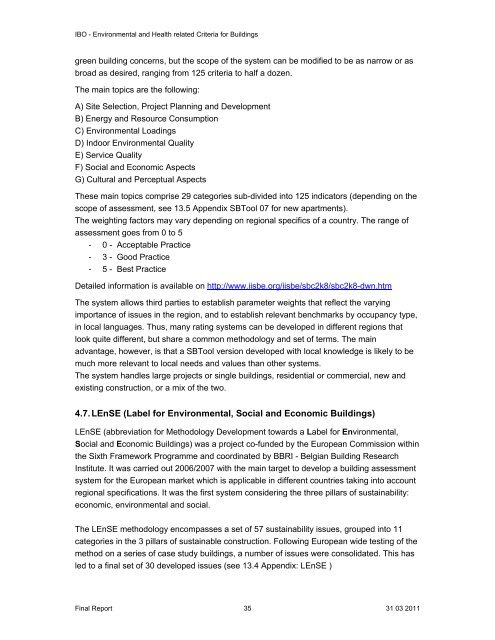Environmental and health related criteria for buildings - ANEC
Environmental and health related criteria for buildings - ANEC
Environmental and health related criteria for buildings - ANEC
Create successful ePaper yourself
Turn your PDF publications into a flip-book with our unique Google optimized e-Paper software.
IBO - <strong>Environmental</strong> <strong>and</strong> Health <strong>related</strong> Criteria <strong>for</strong> Buildings<br />
green building concerns, but the scope of the system can be modified to be as narrow or as<br />
broad as desired, ranging from 125 <strong>criteria</strong> to half a dozen.<br />
The main topics are the following:<br />
A) Site Selection, Project Planning <strong>and</strong> Development<br />
B) Energy <strong>and</strong> Resource Consumption<br />
C) <strong>Environmental</strong> Loadings<br />
D) Indoor <strong>Environmental</strong> Quality<br />
E) Service Quality<br />
F) Social <strong>and</strong> Economic Aspects<br />
G) Cultural <strong>and</strong> Perceptual Aspects<br />
These main topics comprise 29 categories sub-divided into 125 indicators (depending on the<br />
scope of assessment, see 13.5 Appendix SBTool 07 <strong>for</strong> new apartments).<br />
The weighting factors may vary depending on regional specifics of a country. The range of<br />
assessment goes from 0 to 5<br />
- 0 - Acceptable Practice<br />
- 3 - Good Practice<br />
- 5 - Best Practice<br />
Detailed in<strong>for</strong>mation is available on http://www.iisbe.org/iisbe/sbc2k8/sbc2k8-dwn.htm<br />
The system allows third parties to establish parameter weights that reflect the varying<br />
importance of issues in the region, <strong>and</strong> to establish relevant benchmarks by occupancy type,<br />
in local languages. Thus, many rating systems can be developed in different regions that<br />
look quite different, but share a common methodology <strong>and</strong> set of terms. The main<br />
advantage, however, is that a SBTool version developed with local knowledge is likely to be<br />
much more relevant to local needs <strong>and</strong> values than other systems.<br />
The system h<strong>and</strong>les large projects or single <strong>buildings</strong>, residential or commercial, new <strong>and</strong><br />
existing construction, or a mix of the two.<br />
4.7. LEnSE (Label <strong>for</strong> <strong>Environmental</strong>, Social <strong>and</strong> Economic Buildings)<br />
LEnSE (abbreviation <strong>for</strong> Methodology Development towards a Label <strong>for</strong> <strong>Environmental</strong>,<br />
Social <strong>and</strong> Economic Buildings) was a project co-funded by the European Commission within<br />
the Sixth Framework Programme <strong>and</strong> coordinated by BBRI - Belgian Building Research<br />
Institute. It was carried out 2006/2007 with the main target to develop a building assessment<br />
system <strong>for</strong> the European market which is applicable in different countries taking into account<br />
regional specifications. It was the first system considering the three pillars of sustainability:<br />
economic, environmental <strong>and</strong> social.<br />
The LEnSE methodology encompasses a set of 57 sustainability issues, grouped into 11<br />
categories in the 3 pillars of sustainable construction. Following European wide testing of the<br />
method on a series of case study <strong>buildings</strong>, a number of issues were consolidated. This has<br />
led to a final set of 30 developed issues (see 13.4 Appendix: LEnSE )<br />
Final Report 35 31 03 2011
















